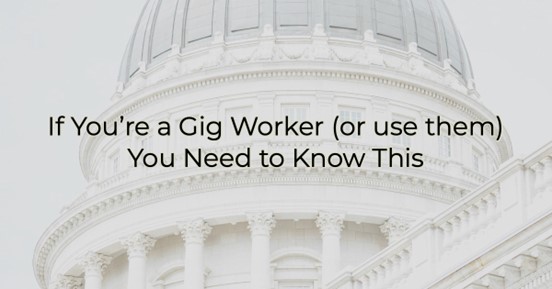If You’re a Gig Worker (or use them) You Need to Know This

If you’re a gig worker, or you use them in your business, it’s important that you are aware of recent legislation that went into effect this month.

What Is a Gig Worker?
A gig worker (independent contractor, freelancer, or contingent worker) is someone who works on a temporary, flexible basis, often for multiple clients or companies. They perform specific tasks, projects, or assignments for a predetermined period, rather than being employed full-time by a single employer.The number of gig employees has grown exponentially over the past few years. In 2024, it’s expected there will be 76.4 million people working as freelancers and indie professionals). These people work in a variety of industries including ride-hailing (Uber, Lyft, etc.), food delivery, freelance writing, graphic design, consulting, and others.
Gig workers enjoy a level of autonomy and flexibility in choosing when, where, and how much they work, something that has become more appealing (and practical) post-COVID. During the pandemic, many people were working from home. Once companies called employees back to the office, some decided to leave traditional work environments for more flexibility.
The gig economy has also grown significantly in recent years due to technological advancements, changing labor trends/opportunities, and the desire for greater work/life balance.
What You Need to Know About The Independent Contractor Rule
The Department of Labor (DOL) introduced the new Independent Contractor Rule on March 11. It sets out six criteria for determining whether a worker should be classified as an independent contractor or an employee. This recent legislation has stirred up significant controversy among freelancers and businesses that rely on gig workers.Here’s why:
This new rule, which replaces an earlier one from 2021 that designated two "core factors"—control over work and opportunity for profit or loss as the deciding factors for classification, poses new challenges for employers in categorizing their workforce. Companies that rely heavily on gig workers (like ride-hailing, food delivery, and creative services), may need to recategorize a significant portion of these independent contractors into unionized employees.
According to the press release issued by the US Department of Labor, “‘Misclassifying employees as independent contractors is a serious issue that deprives workers of basic rights and protections,’ explained Acting Secretary of Labor Julie Su. ‘This rule will help protect workers, especially those facing the greatest risk of exploitation, by making sure they are classified properly and that they receive the wages they’ve earned.’”
But not everyone thinks they’re being “exploited.” Many gig workers, small business advocates, trade groups, and lawmakers have likened this new rule to California's Assembly Bill 5 (AB5), which took effect on January 1, 2020. It required many businesses to treat gig workers as employees. That rule impacted many freelance journalists because it capped the number of articles they could get paid for. AB5 triggered widespread outcry, leading to the California legislature passing over 100 exemptions for affected industries.
On March 21, the U.S. House of Representatives’ Committee on Education & the Workforce moved forward with a proposal to repeal the rule. The committee approved the resolution in a 21-13 vote, paving the way for consideration by the entire House.
Additionally, the Independent Contractor Rule has prompted at least five lawsuits (at the time of this writing), including one with the US Chamber of Commerce and co-plaintiffs the Associated Builders and Contractors, Associated Builders and Contractors of Southeast Texas, American Trucking Associations, Financial Services Institute, National Federation of Independent Business, and National Retail Federation.
The complaint argues this rule will make it difficult for businesses that require the flexibility to be able to scale up or down quickly depending on employment needs (seasonally or otherwise), while also impeding on the freedoms of millions of gig workers to chart their own course of independent work life.
Many gig workers prioritize the flexibility and autonomy offered by contracted employment models, as highlighted in a study by the Harvard Business Review. Karen Anderson, founder of Freelancers Against AB5, strongly opposes the rule, describing it as 'disruptive and cruel.' According to Anderson, the law affects over 600 categories of professions within their membership, causing significant disruption and hardship.
On the other hand, the DOL says the legislation aims to safeguard workers' rights and ensure consistency through the Fair Labor Standards Act. Organizations like More Perfect Union support the rule, anticipating that it will result in higher wages and overtime pay for millions of gig workers.
In conclusion, the shift away from 2021’s simpler two "core factors" framework to a broader six-factor assessment adds uncertainty, leaving employers with challenges in accurately classifying their workforce. Whether you are a business using gig workers or are an independent contractor, this ruling—and the current lawsuits (and potential votes) surrounding it—will have a significant, precedent-setting impact on the independence of the worker. This ruling is just one more stop in the evolving landscape of employment classification but one that we should pay attention to.

